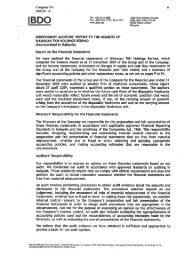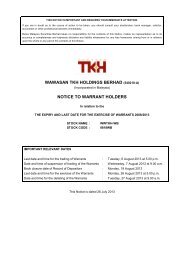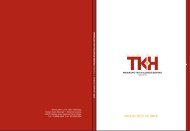Annual Report 2011 (Part I) - Wawasan TKH Holdings Berhad
Annual Report 2011 (Part I) - Wawasan TKH Holdings Berhad
Annual Report 2011 (Part I) - Wawasan TKH Holdings Berhad
You also want an ePaper? Increase the reach of your titles
YUMPU automatically turns print PDFs into web optimized ePapers that Google loves.
WAWASAN <strong>TKH</strong> HOLDINGS BERHAD (540218-A) • ANNUAL REPORT <strong>2011</strong><br />
041<br />
NOTES TO THE FINANCIAL STATEMENTS<br />
31 DECEMBER <strong>2011</strong> (cont’d)<br />
4. SIGNIFICANT ACCOUNTING POLICIES (cont’d)<br />
4.3 Business combinations (cont’d)<br />
Business combinations before 1 January <strong>2011</strong> (cont’d)<br />
(a)<br />
reassess the identification and measurement of the acquiree’s identifiable assets, liabilities and<br />
contingent liabilities and the measurement of the cost of the business combination; and<br />
(b) recognise immediately in profit or loss any excess remaining after that reassessment.<br />
When a business combination includes more than one exchange transaction, any adjustment to the fair<br />
values of the subsidiary’s identifiable assets, liabilities and contingent liabilities relating to previously held<br />
interests of the Group is accounted for as a revaluation.<br />
4.4 Property, plant and equipment and depreciation<br />
All items of property, plant and equipment are initially measured at cost. Cost includes expenditure that<br />
is directly attributable to the acquisition of the asset.<br />
Subsequent costs are included in the asset’s carrying amount or recognised as a separate asset, as<br />
appropriate, only when the cost is incurred and it is probable that the future economic benefits associated<br />
with the asset will flow to the Group and the cost of the asset can be measured reliably. The carrying<br />
amount of parts that are replaced is derecognised. The costs of the day-to-day servicing of property,<br />
plant and equipment are recognised in profit or loss as incurred. Cost also comprises the initial estimate<br />
of dismantling and removing the asset and restoring the site on which it is located for which the Group is<br />
obligated to incur when the asset is acquired, if applicable.<br />
Each part of an item of property, plant and equipment with a cost that is significant in relation to the total<br />
cost of the asset and which has different useful life, is depreciated separately.<br />
After initial recognition, property, plant and equipment, except for land and buildings, are stated at cost<br />
less any accumulated depreciation and any accumulated impairment losses. The land and buildings are<br />
stated at valuation, which is the fair value at the date of revaluation less any subsequent accumulated<br />
depreciation and subsequent accumulated impairment losses.<br />
The land and buildings are revalued with sufficient regularity to ensure that the carrying amount does not<br />
differ materially from that which would be determined using fair value at the end of the reporting period.<br />
The surplus arising from such revaluations is credited to shareholders’ equity as a revaluation reserve,<br />
net of deferred tax, if any, and any subsequent deficit is offset against such surplus to the extent of a<br />
previous increase for the same property. In all other cases, the deficit will be charged to profit or loss. For<br />
a revaluation increase subsequent to a revaluation deficit of the same asset, the surplus is recognised as<br />
income to the extent that it reverses the deficit previously recognised as an expense with the balance of<br />
increase credited to revaluation reserve.<br />
At the commencement of the lease term, leasehold land classified as finance leases shall be recognised at<br />
amounts equal to the fair value of the leased property or, if lower, the present value of the minimum lease<br />
payments, each determined at the inception of the lease. Any initial direct costs are added to the amount<br />
recognised as an asset.<br />
Depreciation is calculated to write off the cost or valuation of the assets to their residual values on a<br />
straight line basis over their estimated useful lives. The estimated useful lives are as follows:<br />
Buildings<br />
Short term leasehold land<br />
Furniture, fittings and office equipment<br />
Motor vehicles<br />
Plant and machinery, tools and factory equipment, roads and<br />
bridges, mould and electrical installation<br />
Renovation<br />
28 - 50 years<br />
30 years<br />
2 - 10 years<br />
5 years<br />
10 - 16.67 years<br />
10 years<br />
Freehold land has unlimited useful life and is not depreciated.







